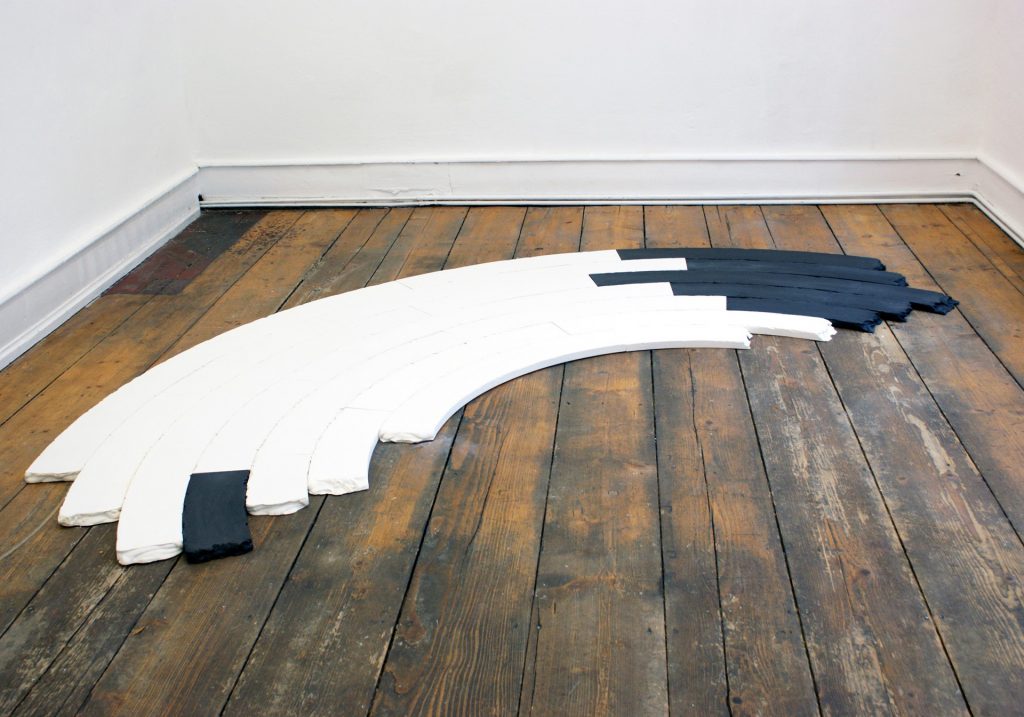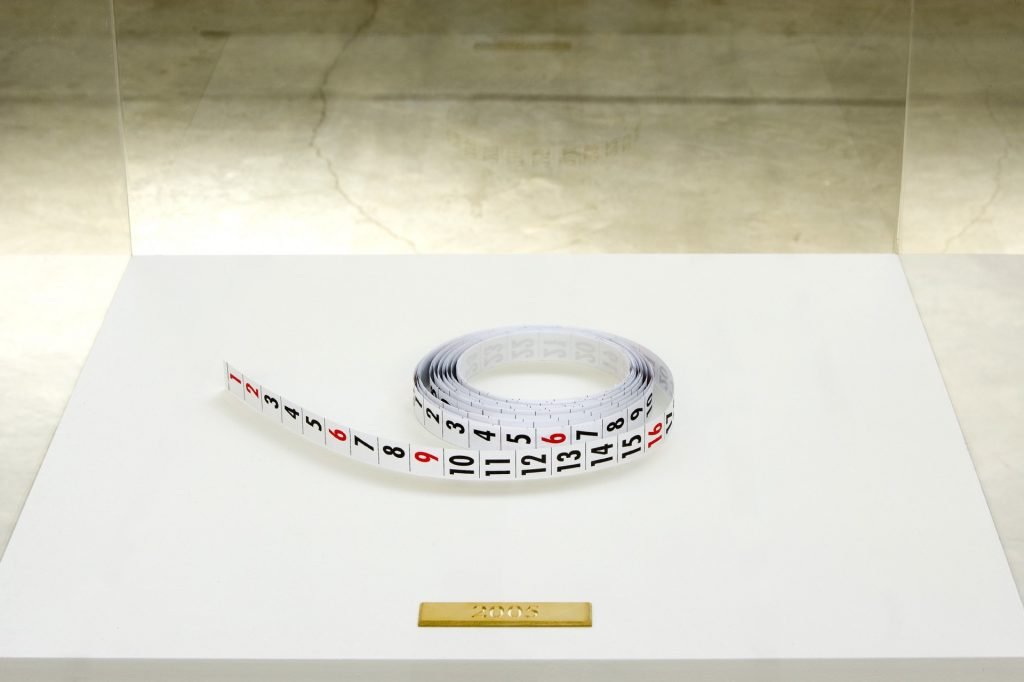Alice Guareschi and M Museum’s Time and Calendar Dial
At the show with the artists: Alice Guareschi elaborates on a rare XVI century Time and Calendar Dial currently part of the M Museum Leuven collection.







At first sight, there is some kind of simplicity to Alice Guareschi’s art, a simplicity that leaves the viewer with limited elements to grasp — a phrase, a chessboard, a mirror. Yet, this is just the first sight. A thoughtful and informed observation of these limited elements reveals how much they couldn’t be further from being limited, for Guareschi inflates them with meaning — not to mention a specific irony — by their being isolated in their display as artworks, by being a part of an intellectual project. For this ‘At The Show With The Artist’ we looked with her at ‘Time and Calendar Dial’, a painting from 16th century Flanders exhibited at M Museum in Leuven. A former background for a clock, this painting incorporates countless layers of meaning in a highly detailed picture. Not many single objects could be so visually different from Guareschi’s artworks than ‘Time and Calendar Dial’, yet not many single objects could be so charged with intellectual reflection either.
One of your artworks is titled ‘Ogni orologio è un labirinto’, which means ‘every clock is a labyrinth’ in Italian. It is a mysterious sentence, since it is not easy to see which properties a clock and a labyrinth have in common. The clock is often an instrument to clarify something about a certain state of affairs, such as the current time, possible zodiacal implications linked to it, seasonal specificities, etc. On the other hand, the labyrinth is an instrument that precisely tries to escape clarification by imposing puzzles to its users. What did you find fascinating in this mysterious sentence to include it in your artwork? And if every clock is a labyrinth, do you think the clock of the’ Time and Calendar Dial’ is a special kind of labyrinth?
The sentence refers to the invisible intersection point of two dimensions: time and space. Both the measurable and incommensurable times, and the different kinds of spaces. It’s not about the properties or the functions of what you are properly calling “instruments”, but rather the powerful reverberations of these two images. Images that allude, without wanting to define them, to two dimensions, which we silently contend with each day: implacable infinity, the vastness of space, incalculable, superhuman time; and the everyday, contingent gesture, the constant and inevitable action of choices and gazes. I think of the labyrinth as a possible way to relate to the present — as a space to be traversed, a time of quick sequences to be reassembled, a variable quantity of choices to make, a series of elements to associate, but out of which it is also possible to gather a single changing reflection. And, as human, I have experienced the extreme relativity of time, how a minute can become a year and vice versa, according to the way we perceive or remember things. The ‘Time and Calendar Dial’ is not only a fine artwork, but also an incredibly dense image: daytime and night-time hours, days, seasons, years, planets, the signs of the Zodiac, the labour activities associated with each of the twelve months… Here too, the objective measurement and the human perspective inevitably overlaps. So, yeah, another kind of labyrinth.
During our conversation you mention that your artwork ‘Days and Hours’ was about a certain way to experience time. Could you talk about how this particular experience and whether there are similarities between the conception of time you explore with that artwork and the one represented by ‘Time and Calendar Dial’?
In the ceramic composition ‘Days and Hours’, time — as it constantly creates more or less durable figures and designs in space — is conceived as an accidental yet inexorable group of fragile forms. I think of this artwork like some sort of snapshot: the crystallization of a moment as it is, but is already not anymore what it was. The seven solids are positioned on the squared surface in both a casual and unavoidable position, which is similar yet not the same in the five other pieces that close the series. A different stillness, as every instant is a different scene, and we are also different ourselves—the subjects, the viewers—minute by minute. In this case, I would say that the relationship with the ‘Time and Calendar Dial’ looks like the one between a part and a whole.
Let’s talk in general about the type of art you make and the type of art the ‘Time and Calendar Dial’ belongs to. There are many similarities and differences of course, yet some seem less obvious. For example, the necessity of knowing some facts linked to the artwork to fully experience it aesthetically is true for both your work and the ‘Time and Calendar Dial’. In other words, both the aesthetic experience of your artwork and the ‘Time and Calendar Dial’ are not exhausted by a visual impression of them, but knowing some facts about them greatly enrich the aesthetic experience. Do you agree with such interpretation? Do you think the aesthetic pleasure of the ‘Time and Calendar Dial’ also derives from the many things one can learn about it? And how much of this aspect of aesthetic experience is conscious in you when you make your own artwork?
I don’t think I agree with this interpretation of my work, but is certainly correct for the ‘Time and Calendar Dial’, which is an artwork made around the year 1500. At that time, and even later, artworks carried much more symbolic and religious meanings, they embodied the wealth and the power, and were made for reasons other than those that move artists nowadays. If we want to “understand” them, to read between the lines, to go beyond the aesthetic pleasure and the marvel at their beauty, we have to study them and to interpret symbols that are lost in the present time. We need to know about who commissioned the work, or why and where it was made, for what reason, etc. If, as you say and I hope, also my artworks are not exhausted by a visual impression of them, it’s not because they carry “contents”, or they are hiding something more important that could be revealed by an explanation of them, but maybe on the contrary because they open the space to think and to question. What I am trying to do as an artist is to materialize ideas and turn them into objects. The aesthetic experience of the viewer comes after, and is not in my hands.
Coming back to the facts linked to the artwork, many of those linked to the ‘Time and Calendar Dial’ are a sort of ethnographic account of Flemish society in the 16th century. In this regard, the paintings on the dial show the different labour activities carried out by both the peasants and the wealthy along with depictions of leisure activities. Overall, the dial is a self-representation of the society in which it was made. Was this ethnographic element of the ‘Time and Calendar Dial’ something that struck you? Is it something you ever take an interest in in your artworks?
Not really. When I look at the ‘Time and Calendar Dial’, first of all I am fascinated by the idea that this bi-dimensional object encompasses so many different scale of time on a single surface. The Flemish scenes are really beautiful to look at, they are full of surprising details and they have amazing colours, but they don’t make the work in my eyes. The structure of the dial does. And to answer to your last question: no, ethnography, as politics, is not a specific interest or a topic of my work. They are both inherent to the work through materials and intentions.
A solo show by Alice Guareschi is opening at Joey Ramone Gallery in Rotterdam on april 28th.
November 17, 2022
